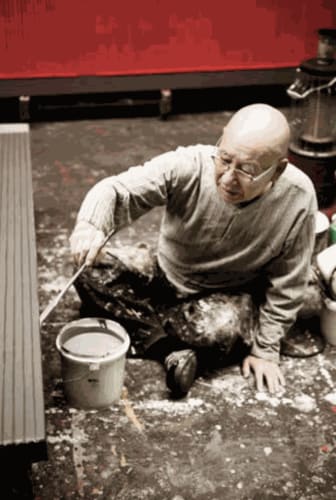Arriving late at the home of renowned Korean artist Park Seo-Bo after fighting Seoul’s traffic, I find him holding court at the head of a long table; on one side sits his daughter-in-law; on the other, a handful of friends and gallerists. At 91, Park remains lucid and sharp, and with the assistance of his family continues to be the epicenter of activity. He is generous with his conversation and over the years has answered familiar questions, offered consistent thoughts, and recounted the same old stories that have come to define his work. Remarkably, his delivery contains none of the worn-out edges of something rehearsed. He is centered and engaged, and adorned with a large amethyst ring and accompanying necklace he appears almost papal. He remains a true believer.
Admittedly, my own approach to, and appreciation of, monochrome painting has never been quite as faithful. Taste and value are inexorably linked, and while I’ve always admired his work, especially in the context of my birthplace of Korea, it has taken two overlays of experience to prepare me for that moment of awe: his solo exhibition at Busan’s Johyun Gallery in 2019 of all-black canvases; and, more recently, at the exhibition “Origin, Emergence, Return,” presented by Johyun Gallery at the Rockefeller Center in New York, alongside my own work and fellow Korean Lee Bae’s.
The black canvases shown in Busan in 2019 are descendants of earlier works and linked to the beginnings of the Dansaekhwa movement and the social context of the early 1970s. The gallery is perched on the cliffs of Busan overlooking a wide expanse of sea that physically and poetically separates the Korean peninsula’s postcolonial history from the islands of Japan. Park was born in 1931, when Korea existed in the shadows and as a colony of Japan—persisting as a culture, not as
a nation—and the depth of his darkened canvases convey a pareidolic parallel to the reparative work of Anselm Kiefer’s charred German landscapes. As a counterpoint, the saturated red paintings at the entrance to the Rockefeller Center show are more present, blazing in an opticality that marks the long-overdue celebration of Korean heritage in New York.
The shared psycho-historical postwar narratives of the 20th century invite monochrome painting’s universal occurrence. Notably, it is not until it reaches the hands of Park Seo-Bo that it becomes an immediate performance of essentialism. Existing in a liminal space of absence and presence and in the usual range of monochrome attitudes and accessibility, Park’s manifested iterations are inseparably fused to the daily rituals of work, family, community, and country. His practice requires absolutes in both the making and the viewing: an acceptance of absence as a point of origin, a total commitment to a zoned-out meditation that combines a peripheral awareness of the infinite and a focus on the singularity of paint, surface texture, and color.
Park’s palette is directly linked to memory and Proustian recollection. His mother’s charcoal-stained kitchen defines the black of his early canvases, while red is drawn from an elemental experience of light and foliage when hiking in the mountains with his wife. Memory is superimposed by the physicality of nature—a nature of infinite details and defined by locations of place and the precise moments they contain; the exact pitch and depth of the charcoal; the residue of countless family gatherings; the specific species and thickness of the leaves and the quality of light which pushes through them. His vision is so keenly focused that molecular minutia emerges as monumental occurrence.
During our recent meeting, Park recalled a period of existential crisis in the late 1990s. Back then, he felt a need to shift his work: at stake was his core integrity, represented by his loyalties to the doctrines of the Dansaekhwa movement he had founded and fought for, versus a need to forge a new path from which to enter the new century. It heralded a threshold moment that challenged decades of uninterrupted faith and proved to be an internal debate that lingers in his voice and gestures all these years later. The situation was so dire at the time, in fact, that Park had even contemplated suicide. But what finally emerged in the early 2000s was a cathartic release, an act of self-reparation, an acceptance of nature’s energy and, in his own words, a point of salvation.
In the end, what his work does for me, or, more precisely, what it means to me, beyond the politics of taste or the grand histories of monochrome painting, is this: Park Seo-Bo is not simply a painter of Korea’s ravaged soul but a man who dares to lead himself, and us, into the light of nature and into the possibility of our own transcendence.
—Jin Meyerson

